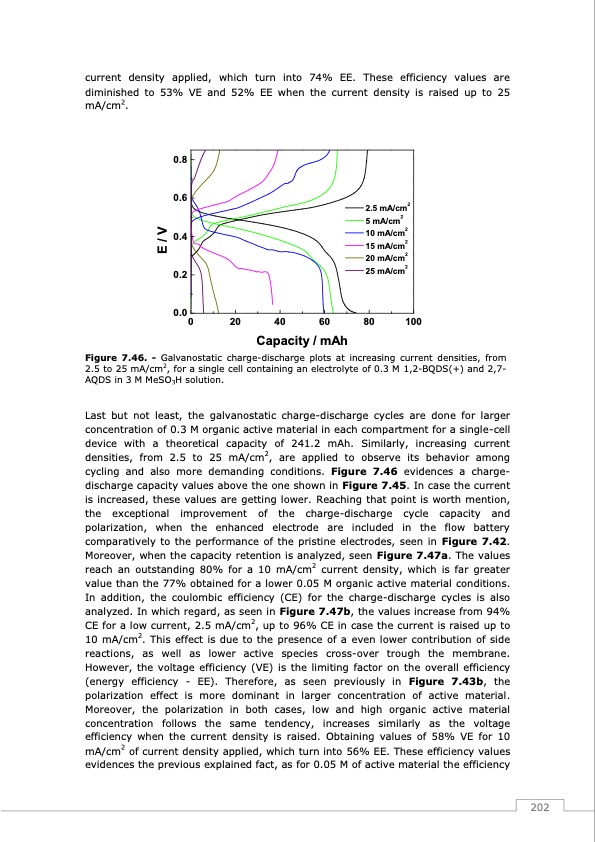
PDF Publication Title:
Text from PDF Page: 203
current density applied, which turn into 74% EE. These efficiency values are diminished to 53% VE and 52% EE when the current density is raised up to 25 mA/cm2. 0.8 0.6 0.4 0.2 2.5 mA/cm2 5 mA/cm2 10 mA/cm2 15 mA/cm2 20 mA/cm2 25 mA/cm2 E/V 0.00 20 40 60 80 100 Capacity / mAh Figure 7.46. - Galvanostatic charge-discharge plots at increasing current densities, from 2.5 to 25 mA/cm2, for a single cell containing an electrolyte of 0.3 M 1,2-BQDS(+) and 2,7- AQDS in 3 M MeSO3H solution. Last but not least, the galvanostatic charge-discharge cycles are done for larger concentration of 0.3 M organic active material in each compartment for a single-cell device with a theoretical capacity of 241.2 mAh. Similarly, increasing current densities, from 2.5 to 25 mA/cm2, are applied to observe its behavior among cycling and also more demanding conditions. Figure 7.46 evidences a charge- discharge capacity values above the one shown in Figure 7.45. In case the current is increased, these values are getting lower. Reaching that point is worth mention, the exceptional improvement of the charge-discharge cycle capacity and polarization, when the enhanced electrode are included in the flow battery comparatively to the performance of the pristine electrodes, seen in Figure 7.42. Moreover, when the capacity retention is analyzed, seen Figure 7.47a. The values reach an outstanding 80% for a 10 mA/cm2 current density, which is far greater value than the 77% obtained for a lower 0.05 M organic active material conditions. In addition, the coulombic efficiency (CE) for the charge-discharge cycles is also analyzed. In which regard, as seen in Figure 7.47b, the values increase from 94% CE for a low current, 2.5 mA/cm2, up to 96% CE in case the current is raised up to 10 mA/cm2. This effect is due to the presence of a even lower contribution of side reactions, as well as lower active species cross-over trough the membrane. However, the voltage efficiency (VE) is the limiting factor on the overall efficiency (energy efficiency - EE). Therefore, as seen previously in Figure 7.43b, the polarization effect is more dominant in larger concentration of active material. Moreover, the polarization in both cases, low and high organic active material concentration follows the same tendency, increases similarly as the voltage efficiency when the current density is raised. Obtaining values of 58% VE for 10 mA/cm2 of current density applied, which turn into 56% EE. These efficiency values evidences the previous explained fact, as for 0.05 M of active material the efficiency 202PDF Image | Redox Flow Batteries Vanadium to Earth Quinones

PDF Search Title:
Redox Flow Batteries Vanadium to Earth QuinonesOriginal File Name Searched:
FJVG_TESIS.pdfDIY PDF Search: Google It | Yahoo | Bing
Salgenx Redox Flow Battery Technology: Salt water flow battery technology with low cost and great energy density that can be used for power storage and thermal storage. Let us de-risk your production using our license. Our aqueous flow battery is less cost than Tesla Megapack and available faster. Redox flow battery. No membrane needed like with Vanadium, or Bromine. Salgenx flow battery
| CONTACT TEL: 608-238-6001 Email: greg@salgenx.com | RSS | AMP |